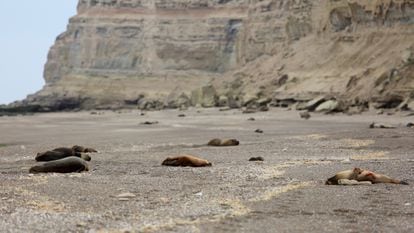
In early August, about twenty sea lions were found dead off the coast of Tierra del Fuego, the southernmost island of Argentina. Analysis confirmed that seven of the marine mammals were infected with the highly pathogenic H5 avian influenza virus. Authorities have since reported outbreaks in different provinces of the country. Since cases were detected in wild birds in Colombia in late 2022, the virus has spread rapidly to the southern part of the continent, and scientists are studying the risk of the virus reaching Antarctica.
On Monday, Argentina reported the latest positive cases among Argentine sea lions in a statement in which authorities warned that “the alert remains.” The samples were taken from dead mammals found in the municipalities of Claromeco and San Blas, in the province of Buenos Aires, and in San Antonio del Este, in the province of Rio Negro. Previously, scientists have found cases on different beaches and protected areas in the provinces of Tierra del Fuego, Rio Negro, Chubut and Buenos Aires.
“This sea lion outbreak started in Peru, then moved to Chile and now to Argentina,” warns Pablo Plaza, PhD in biology and researcher at Conicet, the leading organization dedicated to promoting science in Argentina. explain.The virus affected species first Sophora flavescensCommonly known as the single-haired sea lion, it is a brown carnivore that can weigh up to 350 kilograms. “There are two hypotheses here,” he explains: “Either they became infected because they came into contact with infected birds (which is the most common), or the virus somehow underwent adaptation and spread from sea lions to Sea lion.” Sea lion. “
The H5N1 avian influenza virus currently circulating around the world originated from a pathogen first detected in geese raised in China in 1996. It is a highly contagious subtype that has led to unprecedented spread of the disease among birds. Scientists believe the virus spread from Asia to Africa and Europe – where more than 50 million poultry are slaughtered in a year – and from there via Iceland to North America. The virus was first discovered in wild birds in Colombia in October 2022, from where it spread throughout South America.
It jumped from birds to mammals. “When it reaches the fauna, problems arise because you can’t handle wild animals easily,” Plaza warned. In Peru and Chile, where the situation is particularly severe, more than 15,000 infected sea lions have died, according to researchers – other estimates put the number at more than 20,000. “In the coming weeks, we will have more evidence of the true scope of the epidemic in Argentina,” Plaza said.
In June, cases of H5 avian influenza in sea lions in the southernmost region of Chile were discovered in Puerto Williams, Chile. A report released on August 23 by OFFLU, a global network of animal influenza experts, noted that “there is a substantial risk” that transmission “continues to spread southward and reach Antarctica and its coastal islands,” where the virus remains. exhibit. “This risk is likely to increase in the coming months as wild birds migrate in the spring,” the study wrote, warning that the virus’s “negative impact” on the ecosystem “could be substantial.”
“Everyone is on alert about this virus,” Plaza said. Plaza is part of a team of Peruvian and Argentinian scientists who warned in January that the arrival of avian influenza viruses on the continent threatened protected birds in South America. Following the mass die-off of sea lions earlier this year, the same team published the first draft of research suggesting that the pathogen may have mutated to the point where it can spread between mammals. “This is another step forward in the risk to humans,” Plaza said, clarifying that the risk of human-to-human transmission was currently “low.”
In January, the Pan American Health Organization (PAHO) issued an alert saying an “unusual” outbreak of avian influenza had been detected in the Americas, confirming for the first time human infections in the region. Analysis of the first case in Ecuador reveals a worrying lack of control and surveillance. According to the organization, as of the first week of July 2023, 16 countries had registered animal cases, and two countries, Ecuador and Chile, had confirmed human infection cases. The virus has jumped to humans nearly 900 times since 2003, killing more than half.
To mitigate the spread, Argentinian authorities advise not to handle dead animals or animals with suspicious symptoms, and to avoid direct contact with these animals or with pets. Additionally, they are asking for notification of any suspicion that animals may be infected with the virus. Authorities buried the carcasses of animals infected or suspected of dying from the virus to avoid contamination or infection from other animals or people.
Subscribe here Follow the EL PAÍS América newsletter and receive all the key information on current events in the region.

